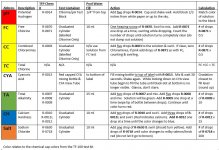- May 11, 2023
- 28
- Pool Size
- 4240
- Surface
- Fiberglass
- Chlorine
- Salt Water Generator
- SWG Type
- Jandy Aquapure 700
When I received the TF-100 (salt) test kit it seemed a bit overwhelming with the various chems so wanted to share my experience and thoughts, having used it for the first time today. It all really does make sense. In my opinion the instructions can be written a little differently, but I am a linear thinker which I know is not everyone's style. Either way, I compiled a chart that made sense to me and wanted to share it in the event it would benefit other first time TF-100 users. I seem to be unable to upload the Excel version so people could modify it to serve their needs. Sorry about that.
I hope this is in some way helpful to people getting started with the TF-100 test kit.
View attachment 491520
- Before starting the testing I found it helpful to have a towel (to dry my hands after getting the pool samples), a paper towel (upon which to set all the test containers after rinsing them) and a pen/pencil. And reading glasses if you are of a certain age! I also grouped the chemicals into the tests for which they were needed.
- To take a sample from a foot below the surface keep the test container upside down when dunking it in the pool and then turn it right side up at about the foot under water mark, which will fill the container. Shake it to splash out the water down to the necessary level.
- Before getting started on the CYA test, the top of the mixing bottle dropper needs to be cut off with a sharp knife. Also, the R-0013 solution has a seal on the top which must be removed by unscrewing the cap.
- Mixing the chemicals is not quite like swirling a wine glass. I found swirling it while on a table worked best.
- It helped me to think about how many potential drops of chemicals I would estimate to be needed on the FC, TA, CH & Salt tests as the final result calculation is based on the number of drops to have the solution change color. For example, my FC was unusually high and used 32 drops. We aren't talking one or two, but would normally expect about 10. Be patient though when you believe you are getting close to the solution turning the necessary color. Swirl a little extra before adding the next drop.
I hope this is in some way helpful to people getting started with the TF-100 test kit.
View attachment 491520



 Yeah, the whole testing thing can be a bit overwhelming or intimidating to some at first, but you get the hang of it pretty quickly. I used to have all kinds of cheat-cheat products I made for myself, but almost never refer to them now becasue they are stuck in my head.
Yeah, the whole testing thing can be a bit overwhelming or intimidating to some at first, but you get the hang of it pretty quickly. I used to have all kinds of cheat-cheat products I made for myself, but almost never refer to them now becasue they are stuck in my head. 
